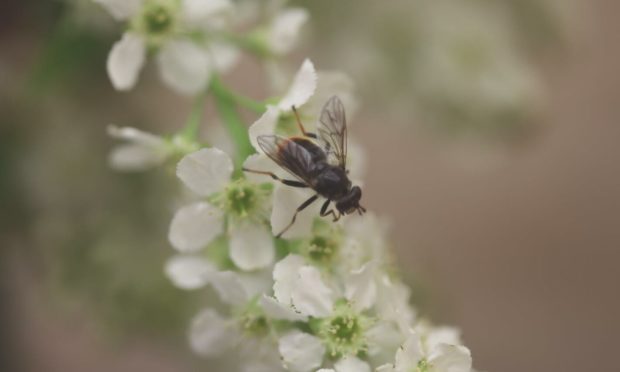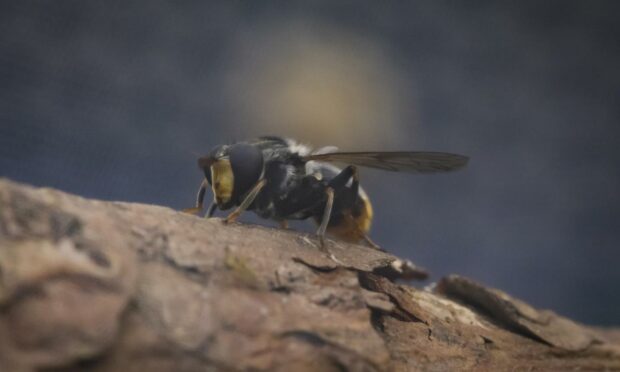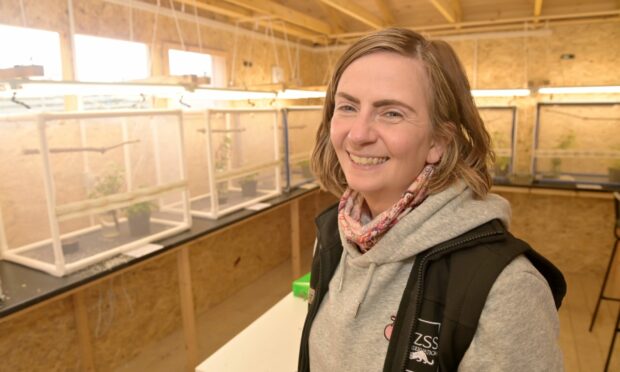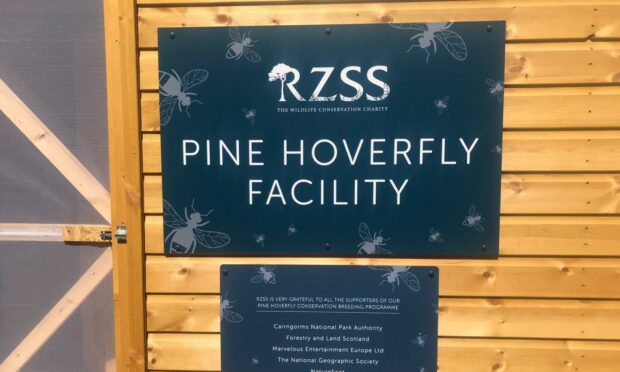A record-breaking breeding season in its Highland love nest may have saved a rare native insect from extinction.
Staff at the Highland Wildlife Park have witnessed the hatching of 6,925 pine hoverfly larvae at its conservation breeding centre.
It is the most larvae of this species ever bred in captivity and could be critical to its future.
No one has seen an adult pine hoverfly in the wild in Britain for over eight years.
Successful mating
Just 25 larvae were brought into the Royal Zoological Society of Scotland’s (RZSS) breeding programme in 2019.
The two small wooden huts that make up the programme’s base at the park now contain more pine hoverflies than are known to exist in the wild in Britain.
In June, it was revealed that the pine hoverflies successfully mated and started laying eggs, the size of full stops.
It represented another success for the painstaking work identifying and matchmaking adult flies to produce future generations.
Adults live for only four to six weeks so the time spent on pairing the flies for breeding is critical.
Now planning for releases into newly-restored habitat in the Cairngorms is underway in collaboration with the Rare Invertebrates in the Cairngorms project.
This is a partnership between the RSPB, Cairngorms National Park Authority, Buglife Scotland, Butterfly Conservation Scotland, and NatureScot.
Dr Helen Taylor, RZSS conservation programme manager, said: “This record-breaking season is a vital lifeline and could represent a real turning point for the pine hoverfly, which is on the brink of extinction in Britain due to habitat loss over the past century.
“Invertebrates are crucial to healthy ecosystems and are disappearing at an alarming rate, though sadly these species are often overlooked until it is too late.
Wild population restricted to one site
“The wild population of this important pollinator is currently restricted to just one site, a forest patch in the Cairngorms National Park.
“It means we are now caring for many more individuals at Highland Wildlife Park than are thought to remain in the wild.
“There has been a huge amount of work involved in this project from our keepers, vets and conservation staff.
“Thanks to this dedication and collaboration, the future is looking much brighter for this rare species. It is really exciting to be able to progress plans to release some individuals back into their wild habitat.”
The project had to overcome a series of challenges to reach the milestone, including lockdowns and furlough leave caused by the pandemic.
Severe winter weather and a delayed spring also meant few flowering plants to feed the adult flies, which emerged early in May.
But in March, the makers of a farming simulation game helped fund the new conservation breeding programme base.
Marvelous Europe Limited, publisher of Story of Seasons: Pioneers of Olive Town (SOSPOOT), donated £20,000.
Support also came from The National Geographic Society, Cairngorms National Park Authority, Forestry and Land Scotland, NatureScot and the Scottish Government.
Planning for release back into the wild
Gaming clothing retailer Insert Coin Tees also donated profits from Story of Season merchandise sales.
Dr Taylor added: “Our partnership with Marvelous Europe opened up interesting opportunities to engage new audiences in wildlife conservation which is key to increasing support for conserving our wee beasties.
“It has been fantastic to see gamers tuning into live Twitch streams that feature the project and entering competitions to name pine hoverfly pupae and a room within our new facility.
“We are immensely grateful for all the support our charity has received from sponsors and partners and I am extremely proud of the work our staff have done to get this far.
“Now it is on to planning releases back into the wild, while maintaining a healthy insurance population in the conservation breeding programme at Highland Wildlife Park.
“There is still a long way to go and lots to learn. Hopefully this is just the start of the success story for this amazing, but little-known insect.”
Pine hoverflies became critically endangered in Britain due to land use change resulting in the loss of the ancient pine forests.
In previous breeding cycles at Highland Wildlife Park, the most pine hoverfly larvae that were produced was 174 in 2020.
New centre will showcase conservation work
In this year’s breeding cycle there were more than 160 pupae with 150 successfully emerging as adult hoverflies.
Those adults laid thousands of eggs, 6,925 of which have now hatched into larvae.
In May the Press and Journal was given behind-the-scenes access to the breeding base which is currently going on in an area of the park not open to visitors.
RZSS plans to build Scotland’s Wildlife Discovery Centre at the site. It hopes the visitor and education centre will showcase some of the conservation work it carries out.



